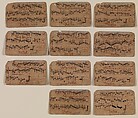Returned to lender The Met accepts temporary loans of art both for short-term exhibitions and for long-term display in its galleries.
Suit of Acorns, from The Playing Cards of Peter Flötner
Peter Flötner German
Publisher Hans Christoph Zell German
Not on view
The Playing Cards of Peter Flötner
Compared to many of his contemporaries, Peter Flötner produced relatively few woodcuts, but included among them is the most arresting deck of cards made in post-Reformation Germany. The cards were hand painted and enhanced with gold. The backs of the cards are inscribed with musical notations and lyrics, with each suit given a particular voice: Acorns, bass; Leafs, tenor; Hearts, treble; and Bells, alto. Each suit is headed by men alone: a king, an upper knave, and an under knave. The suits each have loose thematic connections. In Acorns, five of the pip cards deal with the scatological antics of pigs, which in popular culture were equated with gluttony and lust. In Leafs, several scenes are devoted to the capers of farmers or peasants, underscoring their reputation for drunken and licentious behavior. Hearts are concerned primarily with the pastimes of the bourgeoisie and the lack of chastity. And in Bells, a number of scenes address folly, vanity, and the futility of foolish behavior. The droll lucidity of his images is a pungent reminder that card playing spawns all types of sin, effectively justifying the denunciations of the clergy and civil authorities. But in another sense, these scenes may be seen as the final flourish of imagery that developed out of the monstrous, bawdy, topsy-turvy drolleries that abound in the marginalia of fourteenth-century manuscripts. In the crude subject matter of the cards, Flötner acknowledged man’s baser instincts while warning against them. These striking cards bring to life a microcosmic view of a world long gone while animating social and moral themes that still resonate today. More than any other artist, Flötner fully exploited the conceit of playing cards as a visual polemic to convey his worldview.
Suits: Acorns, Leafs, Hearts, and Bells
12 cards in each suit: King, Upper Knave, Under Knave, Banner (10), 9 through 2
48 cards, of which 47 survive
Germanisches Nationalmuseum, Nuremberg (GMN Sp 7418 1-47 Kapsel 516)
King of Acorns
The king greatly resembles the Holy Roman Emperor Maximilian I.
Upper Knave of Acorns
The Upper Knave is portrayed as a mercenary.
Under Knave of Acorns
The messenger has a letter in his hand, and a hare and a sausage hang from a branch over his shoulder.
Banner (10) of Acorns
A seated lady holds the banner.
9 of Acorns
Two pigs play trictrac (a version of backgammon); a mound of feces on the edge of the board is apparently the prize.
8 of Acorns
Two pigs roast a large mass of fecal matter on a spit over a cushion sitting in open flames.
7 of Acorns
Two pigs eat filth off a large charger.
6 of Acorns
A fool playing a fiddle leads two strolling patrician couples.
5 of Acorns
In a coarse parody of the Saint George legend, a hunchbacked dwarf on a goat attacks a pig with a lance; a female onlooker holds a wreath, the victor’s prize, in her hand.
4 of Acorns
A woman takes her hunchbacked daughter to a doctor to assess her marriage prospects; the learned man examines a urine bottle for a prediction and sees only feces.
3 of Acorns
In a coarse visual play on the traditional scene of two angels carrying a soul up to heaven on a bolt of linen, two pigs have a tug-of-war with a cloth in their maws loaded with a mound of feces.
Due to rights restrictions, this image cannot be enlarged, viewed at full screen, or downloaded.
This artwork is meant to be viewed from right to left. Scroll left to view more.










